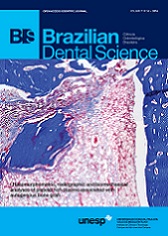Distance learning in dental radiology: Immediate impact of the implementation
DOI:
https://doi.org/10.14295/bds.2014.v17i4.930Resumo
Objective: This study assessed the immediate impact in terms of learning of the dento-maxillomandibular radiographic anatomy in intraoral periapical radiographs after entire replacement of the method of classroom learning by the distance learning using the Moodle platform. Material and Methods: The teaching of this subject by traditional educational setting in classroom was made until the first semester of 2011, “A class” (AC), using radiographic slabs from duplicated films. In the second semester of 2011, “B class” (BC), these radiographic slabs were digitalized, creating the Moodle e-course about dento-maxillomandibular anatomy in intraoral radiographs for distance learning. The impact was assessed by comparison of scores of students from two distinct classes, AC (N=60) and BC (N=62), after application of a similar test with all content of the topic of dento-maxillomandibular anatomy, using T-Student unpaired test (?=0.05). A voluntary and unidentified questionnaire with 12 questions, developed in Google Docs spreadsheets, was used to evaluate the acceptance of students for this e-course. Results: No significant differences (p>0.05) were observed in scores of the students from two classes. Among other questions, all students of BC who completed the questionnaire had interest in content of the available material in e-course, and their satisfaction level on a scale from 0 to 10 had a mean of 8.47 (SD=1.69). Conclusion: The method of distance learning of this subject using the Moodle platform can be utilized with same educational results as of those obtained from a traditional educational setting.Downloads
Downloads
Publicado
Como Citar
Edição
Seção
Licença
TRANSFERÊNCIA DE DIREITOS AUTORAIS E DECLARAÇÃO DE RESPONSABILIDADE
Toda a propriedade de direitos autorais do artigo "____________________________________________________________________" é transferido do autor(es) para a CIÊNCIA ODONTOLÓGICA BRASILEIRA, no caso do trabalho ser publicado. O artigo não foi publicado em outro lugar e não foi submetido simultaneamente para publicação em outra revista.
Vimos por meio deste, atestar que trabalho é original e não apresenta dados manipulados, fraude ou plágio. Fizemos contribuição científica significativa para o estudo e estamos cientes dos dados apresentados e de acordo com a versão final do artigo. Assumimos total responsabilidade pelos aspectos éticos do estudo.
Este texto deve ser impresso e assinado por todos os autores. A versão digitalizada deverá ser apresentada como arquivo suplementar durante o processo de submissão.




























